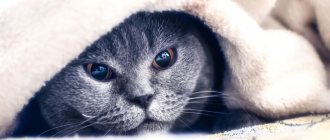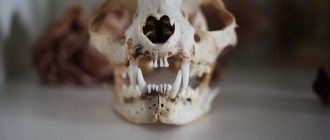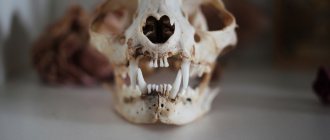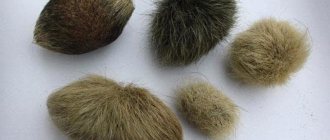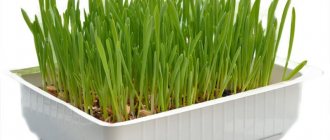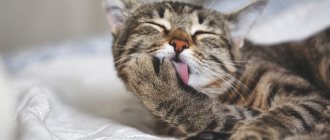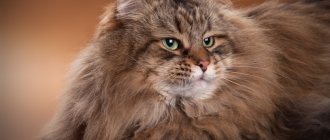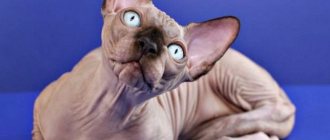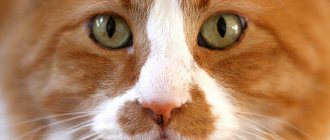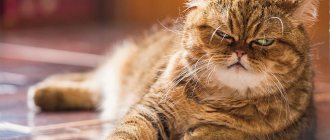People pass gas from time to time, and this is considered normal. Gas formation occurs in the intestines of animals, as in humans. What are the features of this process? Is it typical for cats? Can they fart? How often do you pass gas and what should it normally smell like? What can cause increased gas formation in a kitten or adult animal? Is it dangerous? What to do if your pet constantly farts?
Do they fart or not?
Owners often have a question: “Can cats fart?” Cats fart, and this is a completely normal process of life. However, this happens very rarely. If your cat farts too often, you should pay attention to your pet's health.
During the digestion of food, gases are formed in the cat's intestines. Gases can also form in the stomach due to the action of carbohydrates. Unlike dogs, cats can form a sufficient amount of carbohydrates themselves. Therefore, their increased content in food can cause increased gas formation in the cat’s stomach.
What you need to know about feeding
Diseases of the stomach and intestines, including flatulence, are a consequence of poor nutrition. This is caused by an excess or lack of food, an incorrectly selected diet or menu. At risk are adult cats whose body is weakened and needs constant replenishment with vitamins.
Good food is expensive and is dosed according to the weight, age and activity of the cat. Manufacturers add beans, soybeans, and corn to reduce the cost of formulations. For an animal (which needs natural meat) these are unnatural products. Such ingredients are poorly digested, and together with artificial additives they create an ideal environment for the spread of pathogenic bacteria.
You can't trust a cat's tastes. If previously the animal rejected potentially harmful food, today manufacturers have learned to deceive the instincts of pets. The food contains substances that cause addiction and interest, as well as frequent attacks of farting.
The packages of branded mixtures indicate detailed composition. These are vegetable fats, mixtures of poultry and other animals, and proteins.
Other factors to consider include:
- An irregular feeding schedule leads to farting and gas. Cats are usually fed 2-3 times a day. The best option is in the morning and evening. The food does not have time to be digested and gases form inside the intestines, causing the cat to fart too often.
- If a cat is hungry, the pet will rarely wait for its owner. Leftover food from the table and from the trash can is used. For the owner, this may look like a funny prank from a curious cat. For an animal, this is a threat of health problems.
Whether a cat can fart is a closed question. A funny “habit” is not alien to our smaller brothers
But even such little things are worth paying attention to in order to protect your cat from unpleasant diseases.
Why does a cat fart?
A phenomenon that is perceived from people with hostility, misunderstanding, and sometimes with concern for their health, is perceived with affection from cute pets. When a cat farts, we even want to laugh. But why does a cat fart? Perhaps there is no reason to laugh, but is this a warning to us, the owners, that the animal is not in good health? Or is the problem not so serious that you need to worry about it? Let's look at the reasons why a cat farts. And we will understand how to act and what the cat needs.
Danger of flatulence
Bloating, excessive formation and accumulation of gases can cause flatulence. If a cat hiccups, farts, or belches, we can conclude that there is a malfunction in the digestive system. Due to flatulence, a cat may begin to vomit, diarrhea, cramps, and the abdominal wall may be deformed, which is very dangerous for the animal’s body.
If a cat with such problems continues to eat food, this leads to its incomplete digestion. Food gets stuck in the intestines and begins to rot. The result of this may be intoxication of the animal's body. If your cat's farts smell rotten, this is an important reason to immediately contact a veterinarian.
Flatulence in a pet
Gas in a cat is a common occurrence in veterinary practice. If she passes a small amount of gas 2-4 hours after eating food, this is part of the digestive process and is considered normal. About 90% of the gases released are methane, which has no odor. But if a pet farts more often than usual, and the passage of gas is accompanied by a terrible “amber” and some other signs, this already indicates that he has flatulence.
Flatulence in cats is the process of distension and bloating of the abdomen due to the accumulation of gases and air in the stomach or intestines, which the animal swallows while eating food. The unpleasant odor is the result of the release of hydrogen sulfide and other substances, and the excretion of the resulting excess through the anus is considered a normal physiological phenomenon inherent in all mammals.
Excessive gas production does not mean that a disease is developing in the cat’s body. It is likely that the four-legged pet simply ate food that was unusual for him, and his intestines did not have time to produce enzymes to digest it.
But if flatulence takes a chronic form, this indicates diseases of the gastrointestinal tract. In addition, accumulated gases put pressure on the diaphragm and make breathing difficult. This can cause shock in your pet and even death.
When to go to the vet
If your cat farts frequently and there is an unpleasant odor from the gases, then this is a good reason to visit the veterinary clinic. Self-medication in this case will do more harm than good. Without diagnostics and tests, it is difficult to determine the source of dysfunction and select medications.
Veterinarians advise not to ignore flatulence in pets: it is better to be safe than to carry out long-term therapy for a sick pet. If a cat farts once, then this is a normal reaction of her body; with prolonged gas formation, professional help is needed.
The structure of the digestive system
The digestive system of cats consists of the oral cavity, pharynx, stomach, small and large intestines. The pancreas, duodenum and gallbladder also take part in the digestion process.
An adult cat has 30 teeth in its mouth. The tongue is covered with small, rough papillae, thanks to which the cat can lap up all sorts of liquids. Thanks to saliva, the digestion process begins in the oral cavity. Next, the cat pushes food into the esophagus, which can stretch if necessary.
The food then enters the stomach, where it is digested with the help of gastric juice. From the stomach, food enters the small intestine, where it is finally digested with the help of a pancreatic enzyme.
The processed compressed waste is excreted through the large intestine. It also serves to form beneficial microorganisms and bacteria.
Features of the stomach
A cat's stomach is single-chamber. The inside is lined with a mucous membrane that produces gastric juice. There are two openings from the stomach: one opens into the esophagus, and the other opens into the small intestine.
The cat's stomach serves to store food and control the rate at which food enters the intestines and secretes enzymes necessary for the digestion process. Mixing and grinding of food occurs in it. With muscle movements, it directs food into the small intestine.
When food enters the stomach, its bottom relaxes to reduce intragastric pressure. The smell and taste of food causes the secretion of gastric juice. Digested food is sent to the intestines, and its undigested part remains in the stomach. The more caloric a food is, the slower it is digested.
How do gases form in the intestines of animals, does this happen in cats?
Gas is a byproduct of digestion. They are formed in the intestines of every animal and are the result of the vital activity of bacteria in the intestines. During the digestion of food, microorganisms secrete enzymes that convert the substances absorbed from it into vitamins and other components necessary for the body.
In the process of breaking down food by anaerobic bacteria, a certain amount of gases is formed, which are partially absorbed by them and partially remain in the intestines. If the animal’s body functions without failures, a small amount is absorbed into the bloodstream, while most leaves the body through the rectum.
These substances consist of:
- oxygen;
- nitrogen;
- carbon dioxide;
- hydrogen;
- a small amount of methane.
The components of intestinal gases are odorless. It appears due to substances containing sulfur, which are secreted by bacteria that live in the large intestine. Cats, like any other animal, produce gases in their bodies.
Flatulence in a pet
Gas in a cat is a common occurrence in veterinary practice. If she passes a small amount of gas 2-4 hours after eating food, this is part of the digestive process and is considered normal. About 90% of the gases released are methane, which has no odor. But if a pet farts more often than usual, and the passage of gas is accompanied by a terrible “amber” and some other signs, this already indicates that he has flatulence.
Flatulence in cats is the process of distension and bloating of the abdomen due to the accumulation of gases and air in the stomach or intestines, which the animal swallows while eating food. The unpleasant odor is the result of the release of hydrogen sulfide and other substances, and the excretion of the resulting excess through the anus is considered a normal physiological phenomenon inherent in all mammals.
Excessive gas production does not mean that a disease is developing in the cat’s body. It is likely that the four-legged pet simply ate food that was unusual for him, and his intestines did not have time to produce enzymes to digest it.
But if flatulence takes a chronic form, this indicates diseases of the gastrointestinal tract. In addition, accumulated gases put pressure on the diaphragm and make breathing difficult. This can cause shock in your pet and even death.
The appearance of parasites in a kitten should never be ignored. It is extremely wrong to believe that worms in animals are normal. If the owner discovers that the kitten has such parasites, it is necessary to take immediate action. To do this, you should contact a veterinarian or simply buy the appropriate drug at a pet store. Otherwise, the parasites will multiply in the kitten’s intestines, and this can even lead to death.
Possible causes of flatulence
If you are wondering “do cats fart”, then you are probably interested in the reason for this phenomenon. The reason for the increased formation of gases in the stomach can be a sudden transition of the animal to another food. It is worth remembering that if an animal eats one type of dry food, then abruptly switching it to another can be very harmful to the body. New food should be introduced into the diet gradually so that the body gets used to it.
Another reason may be swallowing air while eating. This is due to the fact that the cat's bowl is too low or high, which is why the animal is forced to take an uncomfortable position while eating. Rapid absorption of food can also lead to swallowing air: this is typical for kittens and young individuals.
The increased content of carbohydrates in food is one of the main reasons for the formation of gases in the stomach. Flatulence is also possible as a result of an allergic reaction to some food component. Very allergenic are cheap foods that contain a large number of various chemical additives that cause addiction in the animal.
Increased gas formation can be caused by inflammatory processes in the stomach and intestines. Congenital pathologies or injuries received during life can disrupt the functioning of the digestive system.
A common cause of flatulence in street animals is viral infection. Another reason for increased gas formation can be dysbacteriosis. A change in the number of microorganisms in the stomach can occur after an animal takes antibiotics or due to inflammatory processes in the body.
What foods cause flatulence?
It is not typical for a carnivore to consume feed with a high fiber content. It is better not to feed those foods that have a carminative effect to cats.
These include:
- pulses;
- cereals;
- granulated with cereals.
It is not difficult for an attentive owner to determine which food causes flatulence in his cat. Sometimes the most ordinary foods can be intolerable due to the lack of enzymes that break down certain ingredients in the body.
This often happens with dairy feeds. If there is no enzyme capable of breaking down lactose, then fresh milk can cause flatulence, although this is not a common occurrence for felines.
Sometimes among cats there are lovers, for example, of cucumbers. An interesting fact is that this vegetable does not cause flatulence in them. This once again speaks of the exceptional individuality of each organism.
What causes increased gas formation?
The following reasons will tell you why a cat farts and why the intestines do not function normally:
- Individual intolerance. Allergies are associated with a negative reaction of the body to certain foods. Most often these are gluten, milk sugar, and artificial ingredients in dry and liquid food. A striking example is budget food. Cheap formulations add elements that cause addiction in the animal, which then farts, suffers from gas and colic.
- Constipation. If a pet cannot empty its intestines or fart, this will inevitably lead to gas formation and other processes that cause discomfort to the cat.
- Limitation of intestinal functions. The pathology of the inability of the intestines to process food is most often a congenital problem. Other factors include injury or previous stomach illnesses. An accurate diagnosis can only be made with long-term observation by a doctor.
- Dysbacteriosis. For normal functioning, the stomach and intestines will need positive microorganisms. Their deficiency leads to decreased immunity and problems with flatulence, when the animal farts constantly. Bacteria are destroyed due to active use of antibiotics or through toxicity.
- Viral infection. If a cat goes outside and does this more than once a day, catching the virus is easier than ever. The most common is parvovirus, found in every second street reveler, for whom farting becomes the norm.
- Inflammatory process. Diarrhea, vomiting, and bad breath will help identify the presence of inflammation. Flatulence in such diseases is a side effect, signaling that it is time for your pet to see a veterinarian.
In addition to diseases, you should also know about the natural reasons why a cat farts a lot.
© shutterstock
Firstly, this is an increased amount of carbohydrates in the body. According to regulations, food for adults should not contain more than 15% carbohydrate particles. Moreover, it is better if these are so-called fast carbohydrates, the digestion and processing of which will not cause problems in the intestines and will not lead to farting.
Secondly, we must not forget about the rules for organizing a place to eat for a cat. When the bowl is too low or high, the cat is forced into an awkward position. This leads to air entering the stomach and natural gas formation, farting. If an animal farts and constantly faces such problems, there is a high risk of critical disruption of digestive processes.
Those who skimp on pet food face this problem more often. The cat farts very often, which is a consequence of exposure to artificial ingredients and flavoring additives that negatively affect the stomach, intestines and the body as a whole. Branded formulations are prepared from natural meat and include the entire vitamin complex aimed at strengthening the immune system.
According to doctors' studies, the main reason that a furry animal farts is swallowing air. Diseases and poor quality of feed take second place. But flatulence is always an individual indicator, although in a healthy cat gases pass out within two hours after eating and in most cases unnoticed by others.
A cat may also swallow air due to its own clumsiness. This is a common problem for kittens who want to eat constantly and try to empty the bowl as quickly as possible. Young cats fart more often. A plastic ball will help moderate the ardor. In this case, the kitten will have to select food and move the ball with its nose, which will significantly slow down its eating.
Why does a kitten or an adult animal have increased gas production, and why is this dangerous?
Excessive gas formation is most often observed in kittens and older cats. This problem may be caused by the following in your pet's diet:
- Dairy products. When preparing your pet’s diet, you need to ensure that the animal consumes these foods no more than 2-3 times a week.
- Soybeans, corn and wheat , which irritate the stomach of a four-legged pet and cause fermentation in it. Despite this, such components are used by many feed manufacturers as a source of vegetable protein.
- Garlic and onion. These products have excellent anthelmintic properties, but they can lead to serious problems with the digestive system.
- Tomatoes.
- Cabbages.
- Potatoes.
- Fatty foods. It doesn’t matter what kind of fat it is - chicken, beef or fish, in large quantities it is contraindicated for cats.
- Bakery products. The yeast contained in these products provokes fermentation.
- Spoiled finished food. Many people mistakenly think that animals are able to digest absolutely any food. It's not like that at all. Poor quality food can provoke irritation of the mucous membrane of the digestive tract and even cause intoxication of the body, accompanied by excessive gas formation, diarrhea and uncontrollable vomiting.
There are other causes of flatulence in cats:
- Obesity.
- Aerophagia. Swallowing air is accompanied by the cat's hasty and greedy eating of food. During the rapid absorption of food, a lot of air enters the animal’s body, which accumulates in the digestive canal. Aerophagia in representatives of the cat family can be of a psychogenic nature. For example, some cats that have suffered severe emotional shock eat very quickly, swallowing air. If an animal is stressed, it may swallow air without even eating.
- Blockage of the stomach with hair that gets into it during licking.
- Worm infestation.
- Constipation. Difficulty with spontaneous bowel movement can be caused by various factors, such as blockage of the intestine with bezoars, ingestion of a foreign body, parasitic infection, neoplasms in the intestine, etc.
- Dysbacteriosis , characterized by an insufficient number of beneficial microorganisms in the intestines of an animal.
- Intestinal inflammation of bacterial or viral etiology.
- Tumors in the intestines.
- Intestinal viruses.
- Various gastrointestinal pathologies.
- Cardiovascular diseases.
- Diseases accompanied by impaired nasal breathing.
Despite the seeming harmlessness of this phenomenon, it is extremely dangerous for the health and life of the pet. Excessive gas formation in these animals can provoke:
- chronic bloating, which will lead to exhaustion, because the intestines will not be able to fully absorb food;
- compression of internal organs, causing disruption of local blood circulation in the affected area;
- ruptures of the stomach and intestines;
- failure of the digestive system;
- inflammation of the bladder and other diseases of the urinary system.
This is interesting: How to put a blanket on a cat?
What to do if a cat farts?
First of all, it is necessary to properly arrange the place for eating. The animal should have a relaxed posture while eating: do not pull its head too low or high, do not throw it to the side.
It is worth taking care of proper nutrition for your pet. Cheap food can be addictive in cats, and they also contain strong allergens. Problems can also arise when feeding an animal with natural food, because under no circumstances should you simply feed a cat fish or cutlets from the table. Natural food must be properly balanced.
If the above measures do not change the situation, and the cat still farts often, you should take him to the veterinarian. Don’t forget that timely measures can save your pet’s life.
Changing your diet
Improper feeding is one of the main sources of indigestion and gas in a cat. A lack or excess amount of food, an incorrectly selected diet, and eating waste from the master’s table provoke gastrointestinal dysfunction. Mature pets are in a subgroup at increased risk for the disease, and their weakened bodies require a sufficient supply of vitamins and minerals.
Note! Good expensive food has a high price, but does not harm animals. They are categorized by age, activity level and body weight. They cannot overfeed or underfeed your furry pet.
Why are cheap options not suitable? They have added foreign components - legumes, soybeans, corn. For a carnivorous predator, they are foreign and are poorly digested in the gastrointestinal tract. Artificial flavor enhancers and other flavorings become a favorable source of proliferation of pathogenic microflora.
You cannot buy food according to your pet’s taste preferences. If earlier he avoided foods that were dangerous to health, now manufacturers manage to lull his vigilance with third-party additives. Inexpensive food is made from components that attract attention and interest the animal. The result of saving is a storm in the stomach due to active fermentation.
Manufacturers of branded mixtures indicate on the packaging the constituent ingredients: proteins, a mixture of poultry, beef, rabbit and other animals, vegetable fats. They do not contain soy, corn and other components that increase the weight of the feed.
Does my cat pass gas after feeding? They can be caused by disruption of the feeding schedule. Three meals a day are allowed; the best option is morning breakfast and evening dinner. If an animal has access to food all day, overeating results in flatulence and other unpleasant symptoms.
Important! A hungry pet is not able to patiently wait for the time when a careless owner remembers his responsibilities. He starts looking for food in trash cans, on the table, and tries to escape into the street. This behavior is not the result of curiosity, but a problem that leads to serious illness.
Hungry cats often look in the trash
Clinical picture
Of course, when a cat constantly passes gas, the diagnosis is quite simple. But it’s still worth remembering that there are other clinical signs that directly indicate flatulence:
- Vomit.
- Diarrhea or constipation.
- Rumbling in the stomach, also known as borborygmy. Occurs when intestinal gas bubbles begin to “roll” in the intestines.
- Copious release of gases through the anus. Sometimes the smell is so strong that it is impossible to be in the same room with the animal.
- Muscle spasms causing severe pain. It is impossible to touch the stomach of a sick cat, since the animal reacts to such attempts very inadequately and aggressively.
In addition, the stomach of a sick pet noticeably swells and feels like a drum . The muscles become very tense. The cat cannot lie or sit quietly, constantly fidgets, and sometimes howls in pain. A pet in this state refuses food, and thirst may persist.
Treatment of flatulence in cats at home
Restoring your cat's digestion is the first thing to do when your veterinarian diagnoses flatulence. Treatment is usually carried out on an outpatient basis, and cats quickly return to normal.
It is important to correctly determine the cause of increased gas formation. The treatment regimen and prescription of medications and procedures will depend on the cause of flatulence:
The treatment regimen and prescription of medications and procedures will depend on the cause of flatulence:
- If internal parasites are the cause of bloating, your doctor will prescribe a course of antiparasitic treatment. Medicines for worms should be prescribed by a veterinarian depending on the type of parasites and the degree of infestation.
- An assessment and review of the diet is necessary if the cause of gas in a cat is an incorrect diet, a sudden change in the type of food, or a transition to a new brand of food.
- If the cause is intestinal disease, therapy will be aimed at eliminating these pathologies.
- Increased gas formation due to too rapid absorption of food can be eliminated by the owner at home without medication. Cats living together should be fed separately to avoid competition over food. The problem of rapid feed absorption is solved by automatic feeders with dispensers. Placing ping pong balls in the food bowl will cause your cat to slow down when eating.
Veterinary drugs for flatulence
Medicines can be given to animals only after a diagnosis has been established as prescribed by a veterinarian.
To treat flatulence use:
- Carminatives – espumizan, simethicone.
- Adsorbents – activated carbon, polysorb.
- Painkillers – antipyrine, traumeel.
- Preparations for normalizing intestinal microflora - lactoferon, bifitrilak, enterol, zoonorm.
- Detoxifying agents – engystol, liarsin.
- Antidiarrheal drugs – bismuth subsalicylate.
Veterinarian advice
Veterinarians have concluded that the most common reason cats fart is swallowing air when eating. The second most important reason is poor quality feed. Economy-segment food is now widely available on the market, and many owners feed it to their pets, thereby causing severe harm to the body. Low-quality food is especially harmful for kittens: the animal’s body is not yet formed and it is very important that it receives all the necessary nutrients and vitamins.
It is worth noting that various diseases are also a common cause of flatulence, which only a veterinarian can identify. You shouldn’t leave things to chance if you have doubts about your pet’s well-being.
At the appointment, the veterinarian must do an external examination and palpate the abdomen. The animal's blood should be taken for tests. An x-ray or ultrasound may also be needed. It is these actions that can help determine the cause of flatulence and take the necessary measures in time.
Diseases
Flatulence is a faithful companion to inflammatory diseases of the digestive system. Most often it accompanies colitis. In addition to rumbling and bloating, the animal experiences tension in the abdominal wall, constipation alternating with diarrhea, blood and mucus in the stool, tenesmus, and pain during defecation. Violation of general condition: apathy, loss of appetite. Colitis can be complicated by a fungal or bacterial infection. It can develop due to improper feeding, helminthic infestation, poisoning, frequent and severe stress.
Causes, symptoms and diagnosis
Having noticed that flatulence constantly bothers your cat, you should not go to extremes, come up with terrible diagnoses, and even less self-medicate. Let’s immediately say that flatulence can occur for hundreds of reasons; we will give the most common ones. So, increased gas production can be associated with a number of ailments or abnormalities in the body’s functioning:
- Constipation - a cat cannot empty its intestines in a timely manner for some reason.
- Allergies or individual intolerances – cats may be intolerant to certain substances, such as milk sugar or gluten. Against the background of immunity, a four-legged animal can happily consume harmful foods, and then suffer from gases.
- The inability of the intestines to properly digest food can be due to a number of reasons, from paresis and insufficient peristalsis to metabolic disorders. Such a problem can only be identified by long-term monitoring of the condition of the cat.
- Dysbacteriosis is a condition caused by an insufficient number of beneficial bacteria in the intestines of an animal. Friendly microorganisms may be destroyed by antibiotic treatment or replaced by other microorganisms.
- Intestinal inflammation is infectious or bacterial - typical signs: diarrhea, vomiting, frequent belching, bad breath.
- Intestinal viruses, such as parvovirus.
- New growths in the intestines, including benign ones.
- Other diseases of the gastrointestinal tract.
In addition to illness, flatulence can be associated with aspects of care. After analyzing the points below, you will understand why a cat farts:
- A diet high in carbohydrates - the cat’s menu should contain fast carbohydrates, but according to generally accepted rules, no more than 13-20% of the total food (for adult cats).
- Incorrect body position while eating food or water - when the bowl is low and uncomfortable and the cat has to take an unnatural position while eating, this leads to swallowing air. A similar situation occurs if the bowl slides on the floor while eating. A small amount of swallowed air is released in the form of belching. If a cat constantly swallows air, this leads to poor digestion and the development of severe flatulence.
The volume of accumulated gases is a very individual indicator. In some cats, flatulence is almost unnoticeable (gases pass for up to 2 hours), while for others it brings noticeable inconvenience: vomiting, diarrhea, severe gurgling in the intestines and, as a result, cramps. It has been established that the main factor in the development of flatulence is swallowing air, followed by swallowing food too quickly.
The problem of swallowing air can be solved relatively easily - purchase a non-slip mat or stand for the bowl. It is more difficult to fight flatulence if it is caused by the fermentation process. If you suspect that the cause of gas accumulation is insufficient quality care, you will find instructions for action in the next section.
If everything is fine with your diet and you are sure of it, you need to go to the clinic and conduct a series of examinations:
- Examination of the cat and palpation of the peritoneum.
- Complete blood test, including kidney and liver parameters.
- Urine and stool analysis.
- Ultrasound and, if necessary, X-ray examination of the abdominal cavity with contrast.
Before contacting the clinic, we recommend that you take a detailed history of the animal. Try to write down in detail everything related to the daily routine, diet, activity and characteristics of caring for your pet. Long-haired cats may suffer from hair clumping in the stomach, if you did not give your ward any preventive medications, this should be indicated in the anamnesis.
Bloating in a cat due to flatulence
So that you have no doubt that your cat really has flatulence and not some other disease, we suggest that you familiarize yourself with the characteristic symptoms of this disorder. So, the cat behaves restlessly, meows pitifully and tries to attract your attention, or, on the contrary, hides in a dark corner and sits there, showing no signs of life.
How to deal with flatulence
If the cat owner is confident that he is buying high-quality food, monitoring the hygiene of the eating area and caring for the animal properly, he should contact a veterinarian. Experts will conduct a number of studies :
- Visual inspection . The doctor palpates the peritoneum and examines the hair and body. Some neoplasms and the consequences of internal diseases appear on the coat, which loses its former fluffiness and shine.
- Blood analysis . Helps clarify liver and kidney parameters, get an idea of immunity and possible stomach problems. Along with this, stool and urine analysis is taken.
- Ultrasound diagnostics . This includes an x-ray examination. It is necessary when there is a suspicion of third-party formations inside the abdominal cavity and intestines that interfere with bowel movements and contribute to constipation and gas formation.
Preliminary preparation will help make the veterinarian’s task easier and understand why the cat farts and passes gas. You should create a detailed daily routine, describe the activity and subtleties of caring for your pet. Long-haired cats require periodic brushing. When self-grooming, the pet swallows hair, which remains in the intestines and interferes with the natural processes of digestion.
© shutterstock
How to choose the right food?
A very common cause of flatulence is improperly selected food. Do not forget that a cat is not a person, and therefore you should not feed it from your table. The cat's food must be properly balanced and contain the required amount of vitamins and minerals. Premium species can boast of a good composition.
Cheap economy-class food most often does not contain normal meat, but includes by-products (production waste). In addition, they contain additives that are addictive.
If you decide to feed your cat natural food, you need to consult a veterinarian to create a properly balanced diet. It is worth remembering that a cat's diet should contain 35% protein, 35% carbohydrates and 30% fat. Cat food must contain meat and meat by-products, grains and vegetables. All this should be boiled and minced through a meat grinder into a homogeneous mass. You should use fish carefully, because its excess in the diet can cause urolithiasis, especially in sterilized animals.
Thus, the answer to the question “do cats fart” is clear: yes, they fart. And this is a completely normal process. However, do not forget that if a cat farts frequently, this is a good reason to consult a doctor.
What to do and how to help your pet
If the flatulence is “mild”, then before the cause is determined and examined by a doctor, you can apply:
- Enterosgel - ½ teaspoon an hour before or an hour after feeding.
- Activated carbon - ¼ tablet 2 times a day.
The course of treatment lasts 5-6 days. If it is not possible to see a doctor, and in addition to flatulence there is a pain reaction, then you can ask:
- Baralgin;
- Spasmadol;
- Antipyrine.
Flatulence is not a disease, but only one of many symptoms. To establish a diagnosis and prescribe treatment, it is necessary to examine the animal.
WHY
Scientists have discovered farting fish
If it seems strange that serious scientists in Scotland are publishing a study on herring farts, what about the fact that they were practically outdone by Swedish scientists who discovered the same phenomenon? This is what great minds do. Bob Batty of the Scottish Association of Ocean Sciences was quite surprised when, together with two researchers from Canada - Ben Wilson and Larry Dill - he made this discovery.
We suggest you read: Preventive rabies vaccination for pets. Rabies vaccines for cats and dogs.
Thanks to him, they received the “Ig Nobel Prize” (a humorous imitation of the Nobel Prize) for incredible things in biology. The Ig Nobel laureates' tour of the UK begins today, and Betty and Wilson will take part in it. Dr Batty, who works at an ocean science center near Oban, and his colleagues were studying whether herring could recognize the sounds made by predators, as whales and dolphins can do.
Using infrared lighting, video cameras and underwater microphones, they studied the herring's behavior throughout the day. “We heard these rattling sounds, which only happened at night, whenever we saw tiny gas bubbles appearing near the tail of the fish,” says Batty. “We also found that the fish released more bubbles the more they were near them. other fish.
In other words, they like to fart in company,” says Wilson. As Betty explains, after analyzing the gas bubbles using chromatography, they determined that it was air that the herring had captured from the surface - this had nothing to do with intestinal bloating. He believes that for herrings, farting is a way of nocturnal communication and a way to maintain the integrity of the school.
During the daytime, they exchange visual information, for example, by reflecting light from mirrored scales. Herring and its relatives release bubbles of gas when they are attacked, but the activity discovered by Dr. Batty and his colleagues serves a slightly different purpose. To the average person, this discovery seems to add little to scientific knowledge, but it is not useless.
As Dr. Batty points out, in sonar surveys, oceanographers who are trying to determine the number and size of fish detect air bubbles, so information about when and how much air is released is of interest to them. Why did the farting herring interest the Swedes? Swedish navy sailors heard strange noises of unknown origin and feared they might be coming from a Russian submarine, so they asked scientists to investigate.
We suggest you read: The cat is hiding: what to do? And why do cats hide in shelters?
As a result, another scientific work appeared, confirming that the herring of the Baltic Sea is no better, it also behaves indecently.

